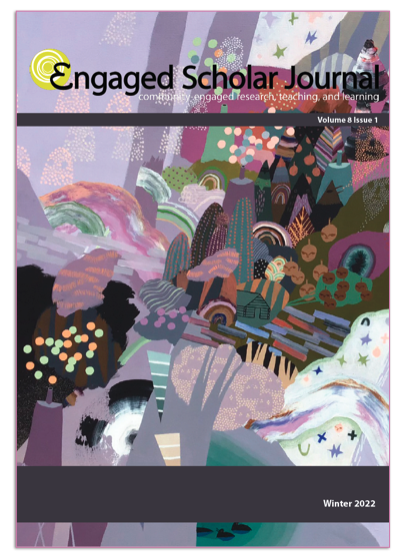FEEL'D NOTES IN PUBLIC PLACES:
Affective Artful Expression for Engagement and Transformation
DOI:
https://doi.org/10.15402/esj.v8i2.70752Keywords:
field notes, arts-informed research, place, engagement, transformationAbstract
For my doctoral research into adults’ informal learning through material objects in four public places in Halifax, Nova Scotia, I used sketchbooks as fieldnote journals. In contrast to objective observations, I recorded during my site visits a panoply of overheard conversations, drawings, remarks, puns, encounters, temperatures, and colours. These and other elements comprised my experiences in each site, and I wanted to represent their gist and connotations through multiple forms of expression. This approach aligns with arts-informed research methodology that celebrates complexity and shared meaning-making with engaged scholarship. I used these notes to produce for each site a written vignette, to introduce and reacquaint others with that place; two of these vignettes appear in the following report. In translating what I came to call my “feel’d,” not “field,” notes into these written pieces, I gleaned new understandings about scribbling and scrawling expressive, affective feel’d notes. I found that engagement enriched my research process, and also fostered a greater awareness of place meanings. I recognize that transformed notetaking has a bearing on understanding, research process, people/communities, and places, and offers methodological insights that carry out and further engaged scholarship knowledge.
References
Barone, T., & Eisner, E. (1997). Arts based research. Thousand Oaks, CA: Sage.
Barter, C., & Renold, E. (1999). The use of vignettes in qualitative research. Social Research Update, 25(9), 1-6. https://sru.soc.surrey.ac.uk/SRU25.html
Beaulieu, M., Breton, M., & Brousselle, A. (2018). Conceptualizing 20 years of engaged scholarship: A scoping review. PLoS ONE, 13(2). https://doi.org/10.1371/journal.pone.0193201
Bertling, J.G. (2019). Layered collaborative visual reflection: Sharing lived experiences and making meaning. Art Education, 72(3), 28-38. https://doi.org/10.1080/00043125.2019.1578022
Burns, L. (2004). Lingering, linking and layering. In A.L. Cole, L. Neilsen, J.G. Knowles, and T.C. Luciani (Eds.), Provoked by art; Theorizing arts-informed research (pp. 214-220). Backalong Books.
Butler-Kisber, L. (2010). Qualitative inquiry: Thematic, narrative, and arts-informed perspectives. Los Angeles, CA: Sage.
Cahnmann, M. (2003). The craft, practice, and possibility of poetry in educational research. Educational Research, 32(3), 29-36.
Clifford, J. (1990). Notes on (field)notes. In R. Sanjek (Ed.), Fieldnotes: The makings of anthropology (pp. 47-70). Cornell University Press.
Cole, A.L, & J.G. Knowles. (2008). Arts-informed research. In J.G. Knowles & A.L. Cole (Eds.), Handbook of the arts in qualitative research: Perspectives, methodologies, examples, and issues (pp. 55-70). Sage.
Connelly, F.M., & Clandinin, D.J. (1990). Stories of experience and narrative inquiry. Educational Researcher, 19(5), 2-14.
Doberneck, D.M., Glass, C.R., & Schweitzer, J. (2010). From rhetoric to reality: A typology of publically engaged scholarship. Journal of Higher Education Outreach and Engagement, 14(4), 5-35.
Eisner, E.W. (1997). The promise and perils of alternative forms of data representation. Educational Researcher, 26(6), 4-10.
Ewing, R., & J. Hughes. (2008). Arts-informed inquiry in teacher education: Contesting the myths. European Educational Research Journal, 7(4), 512-522.
Glass, C.R., & Fitzgerald, H.E. (2010). Engaged scholarship: Historical roots, contemporary challenges. In H.E. Fitzgerald, C. Burack, and S.D. Seifer (Eds.), Handbook of engaged scholarship: Contemporary landscapes, future directions: Volume 1: Institutional Change (pp. 9-24). Michigan State University Press.
Government of Nova Scotia (n.d.) Coronavirus (COVID-19): Restrictions and guidance. Retrieved July 20, 2021, from https://novascotia.ca/coronavirus/restrictions-and-guidance/
Hartel, J. (2014). An arts-informed study of information using the draw-and-write technique. Journal of the Association for Information Science and Technology, 65(7), 1349–1367.
Hendrickson, C. (2008). Visual field notes: Drawing insights in the Yucatan. Visual Anthropology Review, 24(2), 117-132.
Humphreys, Michael. (2005). Getting personal: Reflexivity and autoethnographic vignettes. Qualitative Inquiry, 11(6), 840-860.
Krauss, S.E. (2005). Research paradigms and meaning making: A primer. The Qualitative Report, 10(4), 758-770.
Langer, Phil C. (2016). The Research Vignette. Qualitative Inquiry, 22(9), 735-744.
Mason, S.M. (2020). How objects in spaces help people in places: Material object interactions affecting adults’ informal learning - Arts-informed research using sculptural mobile forms
[Unpublished doctoral dissertation]. Mount Saint Vincent University.
Mombourquette, A. (3 Oct, 2014). Art after dark: Nocturne brings Halifax’s art scene to the people-and pumps up the city’s cool factor. Halifax Magazine. http://halifaxmag.com/opinions/art-after-dark/
Oxford University Press. (2021). Vignette. In Oxford Reference. https://www.oxfordreference.com/view/10.1093/oi/authority.20110803115835480
Peterson, T.H. (2009). Engaged scholarship: Reflections and research on the pedagogy of social change. Teaching in Higher Education, 14(5), 541-552.
SaltWire Network. (12 Oct, 2020). Nocturne 2020 combines in-person and online art and awareness events. Retrieved from https://www.saltwire.com/halifax/lifestyles/local-lifestyles/nocturne-2020-combines-in-person-and-online-art-and-awareness-events-507979/
Sanjek, R. (Ed.). (1990). Fieldnotes: The makings of anthropology. Cornell University Press.
Scalway, H. (2006). A patois of pattern: Pattern, memory and the cosmopolitan city. Cultural Geographies in Practice, 13, 451-457.
St. Pierre, E.A. (2018). Writing post qualitative inquiry. Qualitative Inquiry, 24(9), 603-608.
Walsh, S. (2006). An Irigarayan framework and resymbolization in an arts-informed research process. Qualitative Inquiry, 12(5), 976-993.
Wilks, T. (2004). The use of vignettes in qualitative research into social work values. Qualitative Social Work, 3(1), 78-87.
Wolfinger, N.H. (2002). On writing fieldnotes: Collection strategies and background expectancies. Qualitative Research, 2(1), 85-95.
Zone 1 – Spring Garden & Universities. 137. Sunder. (2017). Nocturne ten: Guide Inside. https://nocturnehalifax.ca/images/uploads/guide/NOC-Guide-2017-FINAL.pdf
Downloads
Published
Issue
Section
License
Authors who publish with this journal agree to the following terms:
- Authors retain copyright and grant the journal right of first publication with the work simultaneously licensed under a Creative Commons Attribution License CC BY 4.0 that allows others to share the work with an acknowledgement of the work's authorship and initial publication in this journal.
- Authors are able to enter separate, additional contractual agreements for the non-exclusive distribution of the journal's published version of the work (e.g., post it to an institutional repository or publish it in a book), with an acknowledgement of its initial publication in this journal.
- Authors are permitted to post their work online (e.g., in an institutional repository or on their website) after the publication of their work in the Engaged Scholar Journal.
- Please note that while every opportunity will be taken to ensure author participation in the editing process, due to time constraints final copyediting changes may be made before publication to ensure APA adherence throughout all submissions.




